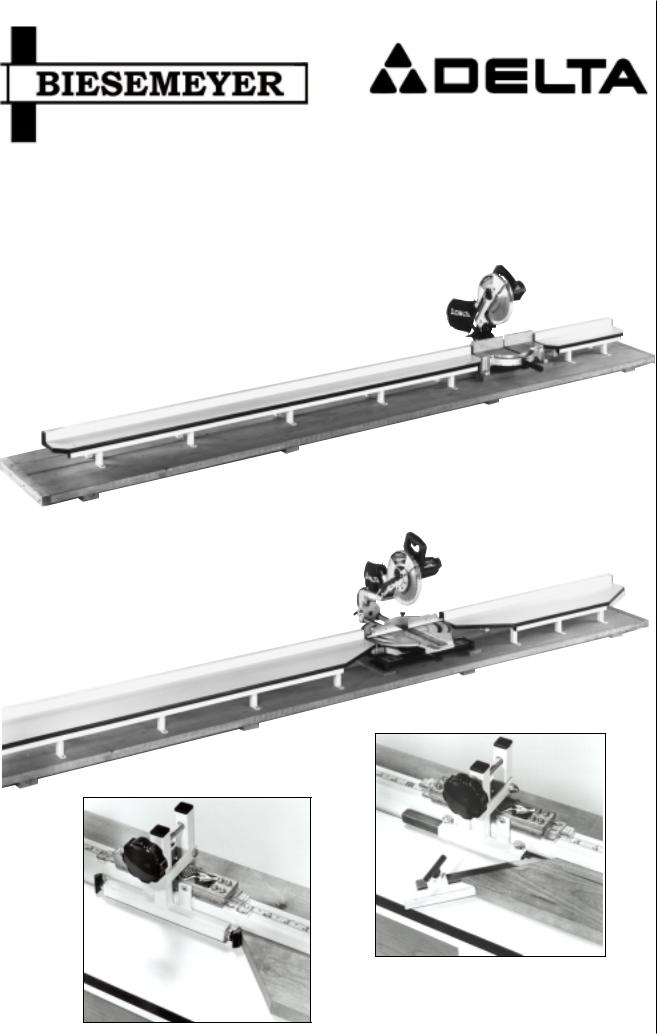Delta 78-802, 78-804, 78-806, 78-808, 79-803 User guide
...
®
T-SQUARE® MITER SAW TABLES AND CUT-OFF STOPS
Miter Tables for 10” Saws (Models 78-802, 78-804, 78-806, 78-808)
Miter Tables for 12” and Slide Saws (Models 79-803, 79-804, 79-806, and 79-808) Cut-Off Saw Stops ( Model 78-989, 78-990, 78-992, and 78-994)
Part No. 1351767
Dated 5-1-2001
<![endif]>INSTRUCTION MANUAL

INTRODUCTION
Biesemeyer® T-Square® Miter Tables and Saw Stops are designed to fit all miter saws and used in conjunction with the adhesive backed measuring tapes that read right-to-left (left hand) and left-to-right (right-hand). Tapes are available in English or Metric/English combination. The use of the stops along with the accessory tables and measuring tapes eliminate the need for cumbersome C-clamps and hand-held measuring tapes, and will make any motorized miter saw more accurate, more productive and more economical to use. The following instructions explain the assembly procedure when using the table system with a Delta miter or slide saw and these instructions are the same for other brands and models of miter and slide saws.
ADHESIVE-BACKED MEASURING TAPES
Model No. |
Length |
Width |
Type |
|
|
|
|
79-056* |
12 foot |
1/2 inch |
Right hand, Metric / English |
|
|
|
|
79-057* |
12 foot |
1/2 inch |
Left Hand, Metric / English |
|
|
|
|
79-061 |
12 foot |
1/2 inch |
Right Hand, English |
|
|
|
|
79-062 |
12 foot |
1/2 inch |
Left Hand, English |
|
|
|
|
79-064* |
12 foot |
3/4 inch |
Right Hand, Metric / English |
|
|
|
|
79-065 |
12 foot |
3/4 inch |
Right Hand, English |
|
|
|
|
79-067* |
6 foot |
3/4 inch |
Right Hand, Metric / English |
|
|
|
|
79-066 |
12 foot |
3/4 inch |
Left Hand, English |
|
|
|
|
79-068 |
6 foot |
3/4 inch |
Right Hand, English |
|
|
|
|
79-069 |
6 foot |
1/2 inch |
Right Hand, English |
|
|
|
|
79-070 |
6 foot |
1/2 inch |
Left Hand, English |
|
|
|
|
79-071* |
6 foot |
1/2 inch |
Left Hand, English / Metric |
|
|
|
|
* Metric/English tapes are not compatible with the Inside Miter Cutoff Saw Stop or the Inside Miter Cutoff Stop.
ASSEMBLY INSTRUCTIONS
1. Place the saw tables, one of which is shown at (A) Fig. 2, |
|
|
on a workbench or other suitable flat surface. |
A |
C |
|
|
|
2. Position the miter saw (B) Fig. 2, next to the miter table as |
|
B |
|
|
|
shown, and using a combination square (C), measure the |
|
|
distance the saw table is below the surface of the miter table. |
|
|
NOTE: If the saw table is higher than the surface of the miter |
|
|
table, the miter tables will have to be raised to the same level |
|
|
as the saw table in the same manner. |
|
|
3. Plane a piece or pieces of hardwood stock (D) Fig. 2, to |
|
|
the same thickness that the saw is below the miter table sur- |
|
|
face. This is the distance which was determined in STEP 2. |
|
|
|
|
D |
|
|
Fig. 2 |
2

4.Mount the miter saw to the planned stock (D) Fig. 3, and using a straight edge (E), make certain the saw table surface is level with the miter table surface, as shown in Fig. 3, and that the saw fence (F) is in line with the fence (A) of the miter tables, as shown in fig. 4
5.IMPORTANT: If you are attaching a scale to the top of the miter table fence, it is important to determine if the miter saw is a center pivot saw in order to accurately use the scale. This can be done as follows
6. Cut a piece of stock (G) Fig. 5, at the 45 degree left miter angle and without moving the work piece, make a mark on the miter table fence at the end of the work piece, as shown.
7. Move the miter arm (P) to the 90 degree straight cut-off position, as shown in Fig. 6, and slide the workpiece (G) until it contacts the saw blade teeth. If the stock does not change position, you have a center pivot saw which can be fastened to the top of the workbench with the saw fence in line with the miter table fence. If the workpiece did move, make a second mark on the miter table fence at the end of the workpiece at its new position, as shown.
E
D
Fig. 3
A
F
E F
A
D
Fig. 4
G
Fig. 5
G
P
Fig. 6
3
